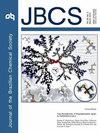生物纳米银与蛋白质封顶:时间知识和观点
IF 1.3
4区 化学
Q3 CHEMISTRY, MULTIDISCIPLINARY
引用次数: 1
摘要
生物源性纳米银是通过银(I)还原合成的,这一过程是由生物界现有的生物分子促进的,主要从植物提取物、真菌生物生产和一些细菌中获得。这种氧化还原过程的确切机制尚不完全清楚。然而,一些研究已经提到氧化还原酶、辅助因子(烟酰胺腺嘌呤二核苷酸氢(NADH)、二氢黄嘌呤二核苷(FADH2))和酚类化合物是参与银(0)和银纳米粒子(银NPs)合成的主要还原物质。生物合成是一个一锅过程,导致稳定的银NP胶体,就其大小,形状和均匀性而言,可以成功地控制;当考虑到它们的表面被一些生物分子覆盖时,它们表现出很强的稳定性,这些生物分子也参与了它们的合成。尽管人们已经做出了巨大的努力来研究封盖生物分子及其与银NP表面的相互作用,但对封盖或包围银NP的生物分子的数量(每平方厘米的确切数量)和类型的了解仍然有限。文献提供了蛋白质capping的详细信息,但在精细生物物理蛋白质特征的许多方面仍然存在空白。为什么某些蛋白质更喜欢与银NP表面相互作用并形成化学键,而另一些蛋白质宁愿与第一层蛋白质发生分子间相互作用的原因尚不清楚。评估封顶蛋白在生物源性银NPs生物活性中的作用是另一个相关的研究领域。某些蛋白质增强银NPs的生物活性,降低毒性;然而,抗菌过程受益于蛋白质封顶的方式尚未被发现。最后,在环境和水中均可发现生物源性银NPs;此外,它们的额外活动和行为必须是已知的,或者至少是假设的。本文章由计算机程序翻译,如有差异,请以英文原文为准。
Biogenic Silver Nanoparticles Capped with Proteins: Timed Knowledge and Perspectives
Biogenic silver nanoparticles are synthesized through silver(I) reduction, which is promoted by biomolecules available in the biological world and mostly obtained from plant extracts, fungal bioproduction, and some bacteria. The exact mechanisms accounting for such oxidoreduction processes are not fully known. However, some studies have already mentioned oxidoreductases, cofactors (nicotinamide adenine dinucelotide hydrogen (NADH), dihydroflavine-adenine dinucleotid (FADH2)), and phenolic compounds, as the main reductive species engaged in the formation of silver(0) and silver nanoparticles (silver NPs) synthesis. Biosynthesis is a one-pot process that leads to stable silver NP colloids that, regarding their size, shape, and uniformity, can be successfully controlled; and show great stability when one takes into account their surface capping by some biomolecules that as well take part in their synthesis. Although great efforts have been made to feature capping biomolecules and their interactions with silver NP surfaces, knowledge of the quantity (exact number per cm2 ) and type of biomolecules that cap or surround silver NPs remains limited. The literature provides detailed information on protein capping, but it still shows gaps regarding many aspects of fine biophysical protein featuring. The reason why certain proteins prefer to interact with silver NP surface and form chemical bonds, whereas others rather have intermolecular interaction with the first layer of proteins remains unknown. Assessing capping proteins’ involvement in the bioactivity of biogenic silver NPs is another relevant research field. Certain proteins enhance bioactivity of silver NPs and lower toxicity; however, the way antimicrobial processes benefit from protein capping is yet to be discovered. Finally, biogenic silver NPs can be found both in the environment and in water; moreover, their additional activity and behavior must be known or, at least, hypothesized.
求助全文
通过发布文献求助,成功后即可免费获取论文全文。
去求助
来源期刊
CiteScore
2.90
自引率
7.10%
发文量
99
审稿时长
3.4 months
期刊介绍:
The Journal of the Brazilian Chemical Society embraces all aspects of chemistry except education, philosophy and history of chemistry. It is a medium for reporting selected original and significant contributions to new chemical knowledge.

 求助内容:
求助内容: 应助结果提醒方式:
应助结果提醒方式:


